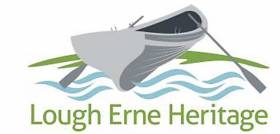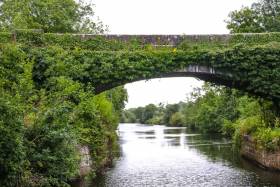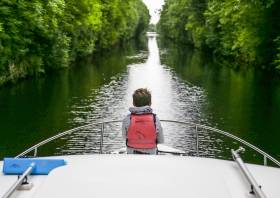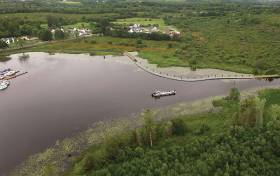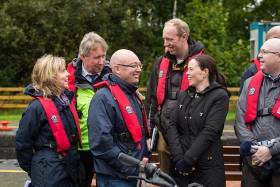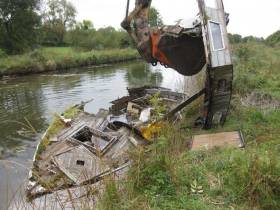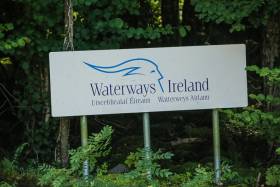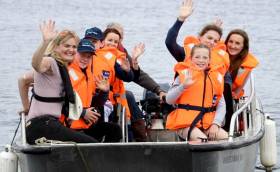Displaying items by tag: inland waterways
The Archaeology of the Erne Waterways Talk
Lough Erne Heritage will hold a free talk at 2:00pm, on Saturday 25 February by Claire Foley on ‘The Archaeology of the Erne Waterways’.
Claire Foley, an archaeologist of some 45 years’ experience, working first from Dublin when she excavated Parkes Castle in Co Leitrim then from Belfast since 1975 working with the Department of the Environment on survey and excavation which included Creggandevesky court tomb in Co Tyrone and the iron age burial in Kiltierney in Fermanagh.
Claire spent 1976 and 1977 recording field monuments in Co Fermanagh and pioneering the recording visits to the many crannogs in the county. The results of this survey, a collaboration with many scholars, were published in 2014.
Most of Claire’s recent professional life has been spent managing programmes to help landowners and communities interpret and manage the many ancient monuments on their land.
Minister Urged to Save Key Piece of Grand Canal Basin: Old Graving Docks
#SaveHistoricDocks - A Dublin docklands business group and waterways enthusiasts have called on Minister for Heritage Heather Humphreys to save a key piece of the Grand Canal basin’s Georgian architecture.
As The Irish Times writes The Inland Waterways Association of Ireland (IWAI) and the Docklands Business Forum (see related story) have initiated a petition this week which asks Ms Humphreys to ensure the basin’s lock gates and graving docks for ships are “restored, preserved and reused” for community gain.
The two groups believes Waterways Ireland wants to sell the graving docks site for further high rise development on the Liffey mouth.
The cross-Border agency is primarily responsible for the Grand Canal Basin and for the surrounding area where the three graving docks were constructed for vessel repair, while Nama also has a lease interest.
The graving docks and lock gates are as important to the heritage of the area as Battery Park is to New York, according to Docklands Business Forum’s chief executive Alan Robinson.
For more on this development click here.
Jehan Ashmore of Afloat adds that recently in an 'Aran Islands Snapshot' was featured the former ferry, Naomh Eanna which has been berthed in Grand Canal Dock for more than a quarter century.
The basin itself is considerably older having opened in 1796 for use of ships entering three docks to and from the River Liffey.
Only in recent years due to the threat of scrapping by Waterways Ireland that the historic Irish built ship was saved by campaigners. Among the reasons cited was due to possible sinking of the veteran vessel which led to the ship shifted from Charlotte Quay to a nearby disused graving dock dating to 1850's.
There have been plans by maritime heritge enthusiasts to restore the 1958 Liffey Dockyard built Naomh Eanna that ran for CIE between Galway City and Aran Islands. The project involved relocating to her former homeport in the mid-west city as a floating museum amongst other functions. The proposed visitor attraction was welcomed by Galway Port with a dedicated berth.
Grand Canal Basin was last used by commercial shipping until the 1960's. The three graving docks (the largest infilled) were used for repairs of small ships and canal barges.
On November 17th, the Association of Irish Local Government highlighted their serious concerns with the proposed legislation and its potential to deny the elected members of Local Authorities to input into proposed Canal Bye-laws that may affect the potential development of the Grand and Royal Canals and the Barrow Navigation say the Inland Waterways Association of Ireland.
The Association of Irish Local Government (AILG) highlighted that City & County Councils have a key interest in the management of Ireland's canal system arising from their responsibilities in the areas of tourism promotion, community and economic development, and the natural and built heritage. The 21 days proposed is too short for the local authority meeting cycle to afford councillors the opportunity to comment on draft byelaws and therefore the period should be extended to 90 days.
The Motion as tabled by Labour Councillor Dermot Lacey of Dublin City Council called on the Minister for Arts and Heritage to amend the Heritage Bill 2016 so as to increase from 21 days to 90 days the period for consultation in relation to bye-laws for canal management proposed to be made by Waterways Ireland, the statutory canal authority.
Dublin City Council, Fingal County Council & South Dublin County Council, have in the past month all unanimously passed emergency motions calling on Minister Humphreys to defer the introduction of the Heritage Bill given their concerns on it. The 90 days period proposed by the above Authorities is currently an approach used by Waterways Ireland already in relation to its corporate plan consultation process.
IWAI advise that while it would welcome and support proper regulations the proposed Heritage Bill does not put user requirements, local communities or tourism at the centre of the regulations. Rather it is a heavy handed approach that will result in a detrimental reduction of boat traffic on the canals.
IWAI believes that it is a negative and imbalanced approach to introduce legislation that penalises 99% of waterways communities to address the problematic area of 1% (due to unlicensed boats, harbour hogging). These matters can be legislated for without effectively penalising the other less populated areas.
Inland Fisheries Ireland Sponsorship Fund 2017 Open for Applications
Inland Fisheries Ireland has launched its Sponsorship Fund for 2017 which will support angling events and initiatives across the country. The fund supported 44 events to the tune of €30,000 in 2016 with a particular focus on initiatives which help grow Ireland’s angling tourism product and support novice anglers. Angling in Ireland is currently worth €836 million to Ireland’s economy annually, supporting upwards of 11,000 jobs.
Inland Fisheries Ireland’s Sponsorship Fund aims to support large international competitions held in Ireland which showcase Ireland’s angling offering and contribute to local economies. The fund also contributes to novice angler events which increase participation in angling among those who have recently taken up fishing. Finally, it also helps initiatives which disseminate information which promote conservation and protection of the inland fisheries and sea angling resource and can include seminars, workshops and training. Support from the Sponsorship Fund can be either financial or resource support from Inland Fisheries Ireland staff members.
Angling offers rural communities the opportunity to increase the number of visitors to the area and in turn, support local business and create jobs by providing a sustainable source of income for both catering and accommodation services. Inland Fisheries Ireland’s National Strategy for Angling Development aims to increase overseas angling visits from 163,000 in 2015 to 173,000 and increase domestic participation of 273,000 anglers annually by 0.5%. If this is realised, angling could bring in an additional €53 million annually and support 1,800 jobs.
Suzanne Campion, Head of Business Development at Inland Fisheries Ireland said: “We are delighted to launch our Sponsorship Fund for 2017 which will support angling clubs and groups nationwide in delivering programmes which ultimately drive angling participation rates. There is a huge network of angling communities nationwide and we want to support them in offering local events which engage domestic anglers, overseas anglers and those who are about to cast for the first time.
Ireland has some of the best wild fisheries in Europe and as a destination, we have a unique opportunity to grow our angling tourism product. This Sponsorship Fund is just one element of our National Strategy for Angling Development which aims to develop our angling tourism potential while also managing and conserving our fisheries resource.”
Inland Fisheries Ireland’s National Strategy for Angling Development is the first comprehensive national framework which will deliver a wide-ranging set of investments, innovations and promotions over the coming five years. It aims to make angling accessible and attractive through information, infrastructure and support, to develop tourism through the promotion of the angling resource and to position angling as a key leisure and recreation pursuit. The Strategy will deliver significant economic benefits in rural communities where much of angling takes place, while also ensuring that fish populations and habitats are protected and conserved.
Applications for funding from the Sponsorship Fund are now invited from angling clubs, associations or any local group organising an angling initiative. The scheme will remain open for applications until Friday, 9th of December 2016 and all applications can be made online at www.fisheriesireland.ie/funding. Awards will be subject to budget availability and adherence to the scheme requirements.
Inland Waterways Association Seek Dedicated Canals Act
The Inland Waterways of Ireland Association President says that the upcoming Seanad Eireann Committee Stage 3 on the Heritage Bill 2016 presents an ideal opportunity for new partnership politics to be demonstrated by the new Partnership Government.
In an IWAI statement John Dolan says 'This can be achieved by the provision of amendments when the bill is reintroduced to Seanad Éireann at 2pm Wednesday November 9th for Stage 3, including the withdrawal of the Canal Acts section from the bill to facilitate the introduction of a dedicated Canal Act with proper pre legislative consultation'
IWAI comment that if a Senator has an initial response of ‘No’ to any of the following short questions then they should be concerned regarding what is proposed in this Bill.
• Is it acceptable that persons other than An Garda Siochana or Customs Officers have the right to stop and search boaters, walkers & cyclists etc. on Waterways Ireland property such as the canal towpaths, Greenways or Blueways? (Heritage Bill 2016 Section 2 7B 1-12)
• Is it acceptable that a Body with no Corporate Governance Structure or Board will be empowered to bring in any byelaws they want with only 30 days Consultation. Local Authority elected representatives have already stated that this is insufficient time to allow them to consider any proposed byelaws? Section 2 7 (2) (a)-(e)
• Is it appropriate to legislate for the introduction of fines & regulations that are overly penal and will not encourage use of the canals and which are not in place on the other Irish inland waterways under the management of Waterways Ireland? Section 2 7 (4) & 7A (1)-(4)
• Is it acceptable to introduce legislation to apply other penalties with no independent appeal mechanism other than the courts? (Section 2 7 (4) & 7A (1)-(4)
• Is it ok to make canals less user friendly by discriminating against tourism development on our Canals by introducing a complete different set of rules, charges, regulations and fines that are not in place on the adjoining Waterways? How will this encourage tourism growth?
The Inland Waterways Association of Ireland acknowledged the support of all Senators and TD’S in the Dail and Seanad for their cross party support and pledges during the 2016 elections. Significant numbers supported the IWAI call for a dedicated Canal Bill with pre legislative consultation with canal users, local canal communities, elected Local Authority Representatives and Local Authority Management and the tourism sectors.
IWAI believes that it is a negative and imbalanced approach to introduce legislation that penalises 99% of waterways communities to address the problematic area of 1% (due to unlicensed boats, harbour hogging). These matters can be legislated for without effectively penalising the other less populated areas.
IWAI believe that any proposed legislation should:
• promote the development of the tourism potential of the canals and supports tourism initiatives on the canals, such as the IWAI Green and Silver circle trip through Dublin via both canals
• equally provide for the regulators and the users requirements
• in the absence of alternative private marinas on the canals provide for boaters moving through these linear waterways in safe areas, not isolated known problematic areas and without having to risk €150 per day fines after five days
• allow for the introduction of bye-laws that put user requirements, tourism development and local communities at the centre of the regulations in a manner that allows adequate consultation
• ensure that the enforcement & penalties regime governed by these bye-laws include a suitable independent appeals mechanism
• protect and maintain navigation heritage and usage for future generations
IWAI advise that while it would welcome and support proper regulations the proposed Heritage Bill does not put user requirements, local communities or tourism at the centre of the regulations. Rather it is a heavy handed approach that will result in a detrimental reduction of boat traffic on the canals.
The proposed Heritage Bill (2016) gives Waterways Ireland, the authority to appoint “officers” to carry out stop and search and seizure activities on boats and personal property on the Grand Canal, Royal Canal and River Barrow.
In the Republic of Ireland, search and seizure acts are limited to a number of specially trained and professional groups such as the Gardaí, Health a Safety Inspectors and Customs Officers. The boats affected by this new act include residential barges, hire boats and barges, restaurant barges, motor cruisers and fishing boats.
Boats will opt to move to the other Irish Waterways, managed by the same regulator, Waterways Ireland, where the regulations and facilities are more user friendly and where there are no oppressive fines and penalties.
The powers proposed within the new Act will affect those on the waterways of Carlow, Dublin, Kildare, Kilkenny, Laois, Longford, Meath, Offaly and Westmeath.
Minister Ring T.D. has awarded €500,000 to Waterways Ireland for the completion of the Shannon Blueway between Leitrim Village and Drumshanbo town. The project will include an iconic boardwalk around the southern side of Acres Lake. The attractive new walkway will be constructed partly on land and a significant section will be designed to float over the water. This work will complete a 14–km section of the Blueway, bringing it into the Blueway network which is now nearing 200km in length running across Leitrim, Roscommon, Longford and Cavan.
The Shannon Blueway is a new recreation and tourism concept that has been developed by Waterways Ireland and a number of key partners including Leitrim, Roscommon and Longford County Councils, the National Trails Office and Canoeing Ireland.
The Blueway is a series of quality multi-leisure activity trails both on and off water that offers a wider and deeper experience through associated activities and attractions. There are now 8 activity providers operating on the Blueway and accommodation & hospitality sector in the wider geographical area developing interesting and exciting packages for families and friends to experience. (www.bluewaysireland.org)
The first section of Blueway (funded by the Rural Recreation Grant Aid) opened in October 2014 and has achieved huge success and recognition to date. It comprises 3 looped walks and 16km of canoe trails connecting Carrick-on Shannon to Drumshanbo. It has already received two awards and has attracted over 100,000 visitors since opening.
The grant approved by Minister Ring T.D., will provide a critical connection in the walking and cycling element of the Blueway. The iconic boardwalk provides linkage for the existing 14km of looped walks to the facilities and services at Acres Lake and Drumshanbo town another key element of Blueway infrastructure.
Waterways Ireland and Leitrim County Council, manage and operate a fully serviced community and boating resource at Acres lake which includes a marina, car-parking, toilets and showers, outdoor swimming pool, tennis courts, angling facilities and the Sliabh an Iairann Visitor Centre. By connecting these facilities to the existing looped walk and cycle path the area can be utilised as a trail head and will anchor and integrate the Blueway in the town of Drumshanbo and the wider Roscommon and Leitrim hinterland
The project will involve the construction of a path from the current terminus near Drumhauver Bridge to the edge of Acres Lake; the procurement and installation of the floating walkway, and the construction of a new path linking the walkway to the services at Acres Lake. It is anticipated geotechnical works and preliminary site works will commence by the end of November 2016. Waterways Ireland is in the process of procuring the floating walkway. The scheme is expected to be completed by May 2017 in time for the main boating and tourist season.
Waterways Ireland Welcomes Industry Group on Educational Visit to the Shannon Blueway
Waterways Ireland welcomed members of the Destination Fermanagh Industry Group on their recent visit to the Shannon Blueway in Co Leitrim. Private and public sector members of the group visited this latest Waterways Ireland award-winning innovation and met the development and marketing teams as well as local businesses that have started up or grown around the Blueway.
Welcomed by Waterways Ireland's Regional Manager Éanna Rowe and Director of Business Development, John Boyle, the visit began with an information session in the Lough Allen Hotel. Boats provided by Leitrim Quay were used to take the group from Drumshanbo to Acres Lake, where they toured the site and the new visitor centre and then onto to Drumleague. From Drumleague the group walked, used bikes provided by local business Electric Bike Trails or stayed on board the Leitrim Quay boats all the way to Battlebridge.
In Battlebridge the group toured the lock and lock-keepers house before crossing the river to Battlebridge Glamping where they enjoyed a tour of the site and the pods and walked into Leitrim village to have lunch in The Barge.
Eddie Mc Govern, Tourism Development Officer for Fermanagh & Omagh District Council said "it gave me a totally different perspective of an area, that I thought I knew very well. It's beautiful and cycling along the canal (even in the rain) showed the potential of the area. Those electric bikes are so good ".
John Boyle Waterways Ireland, commenting on the visit said "Waterways Ireland have developed and led the Blueways initiative across our waterway network as we believe in its potential to activate significantly increased recreational and tourism use of the waterway corridors. The visit of Destination Fermanagh members is important to grow awareness of this award-winning initiative, and to provide a deeper understanding of how working together, a Blueways initiative on the Erne system could deliver more visitors to Fermanagh".
Progress is continuing on this collaborative approach to Blueway development on Lough Erne.
Sunken Craft Removed From the Barrow Line of the Grand Canal
The salvage and disposal of a number of sunk and abandoned vessels from the Barrow Line of the Grand Canal at Lowtown took place on 12-13 October 2016 by Waterways Ireland.
As part of the canals clean up a number of sunken and abandoned, non permitted, vessels were targeted for removal and disposal from the canals. Every effort was made to trace owners of the vessels via the permit database, Shannon Registration number or local knowledge. No owners or interested parties were found.
Upon inspection of all vessels by the Assistant Inspector of Navigation, it was determined that none of the vessels were salvageable and were beyond economic repair. Consequently it was decided to remove and dispose of the wrecks. A company was contracted to undertake the work.
The first vessel, a steel hulk has been sunk on the Eastern bank of the Barrow Line for approximately 5 years. Accumulated debris and rubbish hindered the pump out but eventually the vessel was floated. The vessel was recovered onto the canal bank after 7 hours of work. As initial cuts with cutting equipment were made, Waterways Ireland received a request from Heritage Boat Association to pause the removal of the vessel as it potentially had heritage value. No further cutting was done and the hulk has been left on the canal bank, overturned to prevent further ingress of water, while the HBA's interest is followed up.
Removal of the other vessels went ahead as planned. Most vessels broke up as they were being towed to the Western bank for disposal. A diver in the water recovered all floating debris and heavy materials were recovered with the assistance of a digger bucket.
One vessel was pumped out and returned to its owner who was identified after a number of phone calls on 13th October.
Vessel removal was completed on 13th October with contractor returning on site on 14th October to "dress" the bank and remove any remaining debris.
Waterways Ireland requests owners of boats on the Grand Canal, Royal Canal and Barrow Navigation to ensure they have a valid permit and that the Inspector of Navigation has been provided with up to date contact details.
Canal Passages Into & Out of Dublin Suspended Due to Anti–Social Behaviour
Waterways Ireland is advising masters and owners of vessels that passages into and out of Dublin are presently suspended in light of recent anti-social behaviour which has given rise to safety concerns for boaters and staff alike.
Inspector of Navigation C.J.Lawn says the 'present arrangements are being reviewed' to ensure that there is adequate security to ensure safety for all concerned in order that passages can be resumed at the earliest opportunity.
IWAI Promotes Waterways for All At 'Carrick Cares' Day
As members of the Inland Waterways Association of Ireland (IWAI), we sometimes take access to over 1000km of lakes, rivers & canals for granted writes Alan Kelly. The fact that we can just hop onto a boat and cast off on a journey of exploration is a real joy. It is this feeling of joy that IWAI Carrick on Shannon aims to share through the ‘Carrick Cares Day’ event, which this year took place on Saturday August 27th at Lough Key Forest Park in Co Roscommon.
This event introduces the waterways to some very special guests, many of whom are wheelchair bound or have other special needs. For many of the visitors, Carrick Cares Day provides an opportunity to partake in water based activities, an opportunity that might not have been available otherwise. The idea, originally conceived by IWAI Carrick members Tom Meegan and Linda Garland, has gone from strength to strength since its inception in 2011. For the past 5 years, IWAI Carrick members along with members from other IWAI branches give their time unselfishly to participate in the Carrick Cares Day. The event also enjoys the support of Waterways Ireland.
The location of Lough Key Forest Park provides the perfect setting for the Carrick Cares Day event. IWAI members gather the evening before and prepare for the forthcoming day, erecting tents & assembling BBQs and tea stations. Others are busy baking cakes while a further team look after the health and safety to ensure total accessibility for the visiting guests.
Participants start arriving from mid-day. Numbering over 100, guests and their helpers arrive from various Care Centres including Brothers of Charity, Boyle. Also well represented is the Irish Wheelchair Association with branches from Sligo, Drogheda, Athy, Carrick on Shannon & Athlone. You can feel the excitement building as our guests arrive. Each and every one of them has a smile on their face in anticipation of the day.
Guests experience a trip in open wheelchair adapted boats, try their hand at fishing & have an opportunity to cruise out on the lake. They get to explore the beauty of Lough Key Forest Park and all it has to offer. Carrick Cares Day 2016 involved 63 IWAI volunteers, 28 cruiser trips, 34 wheel chair boat trips taken, 19 fish were caught and 186 burgers enjoyed, not to mention the tea, coffee and homemade cake that was consumed. Live music followed the refreshments rounding off an event that is in keeping with the IWAI aim of ‘the use of the waterways for all’.


























